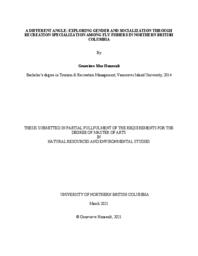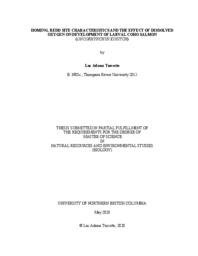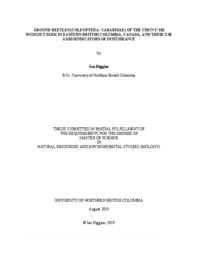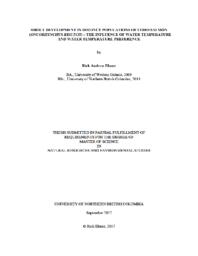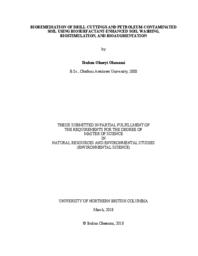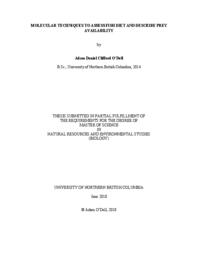Erasmus, Daniel
Person Preferred Name
Daniel Erasmus
Related Works
Content type
Digital Document
Description / Synopsis
Archaea, a domain of organisms possibly linked to the ancestry of eukarya and bacteria, displays a dichotomic evolutionary pattern. Haloarcula marismortui (H. marismortui), an archaeon discovered in the Dead Sea, has unique traits enabling survival and thriving in hypersaline environments. Research in this study includes investigating the Trk potassium transport system, which may contribute to stability of this archaeon in varying extreme environmental conditions. A primary focus on the TrkE protein role in the system, also known as SapD , which in Haloarcula marismortui is OppD1. The Trk system has been studied in several species, and through each it has been consistently found to be homologous to the E. coli sapABCDF operon, which has been found to encode an ABC transporter. Within this operon in E. coli TrkE is coded for by the SapD gene. The goal of this study was to clone the TrkE homolog from Haloarcula marismortui and continue with further research into the characterization of the protein to aid in the prediction of its overall function in potassium transport. Data in this study strongly suggest the size of the H. marismortui homolog of TrkE, OppD1, is larger than its E.coli homolog by approximately 10,000 Daltons. Further analysis also identified that the mainly alpha-helical protein has a significant sequence identity with SapD. Future considerations include looking at the purpose of the N-terminal extended region of OppD1 not seen in SapD, and further analyzing OppD1 for structure changes in varying salt conditions and possible binding partners. The exceptional survival skills of H. marismortui in high-salinity environments, possibly facilitated by the Trk system, make it an excellent model for studying halophiles. These insights offer valuable understanding into how halophiles maintain cellular integrity under harsh conditions, especially regarding OppD1's potential role within the Trk system for ion transport and osmotic regulation in different environmental settings.
Origin Information
Content type
Digital Document
Description / Synopsis
Studies of how gender is characterized, performed, and understood in outdoor activities in relation to skill development are limited, but growing. This research explored gender and social relationships across levels of recreation specialization in fly-fishing among anglers in Prince George, BC. Semi-structured interviews were conducted with 23 participants, 11 of whom then attended a level-specific fishing day during which participant observation was conducted. Interviews were transcribed and coded. Four main findings were derived. First, anglers’ social relationships shifted from dependence on others to intentional self-expression. Second, anglers learned to belong ecologically and socially through skill development and equipment use. Third, anglers’ relationships with fish moved from possession to communion. Fourth, anglers’ described escaping their daily routines to engage with rural places and fishing. The analysis and discussion show how masculinity was constructed and performed, and highlight the roles of socialization, behaviors, and equipment in shaping and gendering rural settings.
Origin Information
Content type
Digital Document
Description / Synopsis
Life histories of Pacific salmon are remarkable in that they return to specific freshwater sites to spawn after multiple years of ocean residence. In Chapter 1, I investigated site fidelity at a reach scale for Interior Fraser Coho Salmon (Oncorhynchus kisutch) (IFC). Coho Salmon eggs were incubated at known spawning locations in the Coldwater River, British Columbia, to obtain reference data for comparison to otolith signatures of returning adult salmon. The majority of adults (67%) returned to their natal spawning locations at the reach scale, while 33% strayed to other spawning sites within the Coldwater River, illustrating straying at small scales. Straying to novel incubation sites at the reach scale demonstrated plasticity in homing within a watershed. In Chapter 2, I investigated the characteristics of the hyporheic redd zone over two years where Coho Salmon were observed to spawn. Within a reach, physical variables were homogenous, but heterogeneity was found among reaches where Coho Salmon were observed to spawn – particularly for intragravel temperature and dissolved oxygen. The difference in temperature and dissolved oxygen among sites had a pronounced effect on survival, rate of development, and emergence time for Coho Salmon fry. Heterogeneity among spawning locations demonstrate trade-offs that exist between rate of development and survival. Chapter 3 investigated the effect of low and variable dissolved oxygen on developing salmon embryos. A family effect was found as smaller eggs produced smaller alevin, but the effect of low dissolved oxygen on growth was also greater for the families with small eggs. Treatment affected rate of development and initially had an effect on length and mass, but by button-up there was no longer an effect of low dissolved oxygen on size. My work demonstrates plasticity in Coho Salmon at different life stages. Plasticity is important for utilizing new habitats or adapting to existing habitats as they change.
Origin Information
Content type
Digital Document
Description / Synopsis
The Chun T’Oh Wudujut is a provincial park located in the Interior Cedar-Hemlock biogeoclimatic zone. My objective was to assess the use of carabid beetles as bioindicators of change in this unique interior temperate rain forest ecosystem. Using a combination of morphotyping and DNA barcoding, I examined the diversity of carabid beetles in three different habitat types: clear-cuts, undisturbed old growth, and disturbed old growth subject to frequent human traffic. Nineteen species of carabid were observed, with the highest diversity occurring in clear-cut sites. Carabid diversity in both old growth habitats was similar, but differed from that in the clear-cuts. Temperature and relative humidity proved more variable in clear-cut sites; this may impact carabid biodiversity, and should be measured in future bioindicative studies. Several species of carabid beetles (alone and in combination) were identified as possible bioindicators, including Scaphinotus marginatus, Trechus chalybeus, Pterostichus herculaneus, and Pterostichus riparius.
Origin Information
Content type
Digital Document
Origin Information
Content type
Digital Document
Origin Information
Content type
Digital Document
Origin Information


